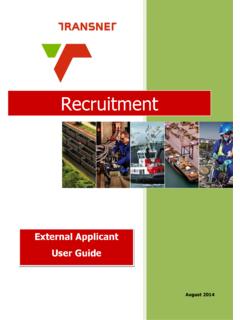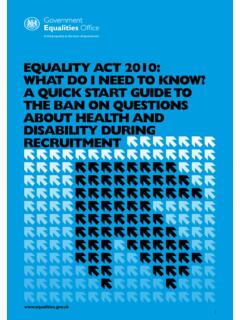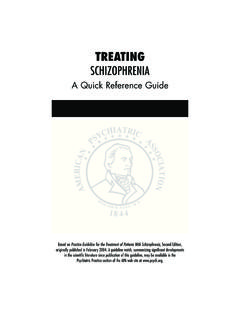Transcription of Facilitator Guide - Centers for Disease Control and …
1 Centers for Disease Control and Prevention National center for HIV/AIDS, Viral Hepatitis, STD, and TB Prevention Division of Tuberculosis Elimination Developed in partnership with: Curry International Tuberculosis center Heartland National Tuberculosis center New Jersey Medical School Global Tuberculosis Institute at Rutgers Southeastern National Tuberculosis center Facilitator Guide 2 3 Table of Contents 5 Introduction .. 5 Overview .. 6 Purpose of this Course .. 6 Target Audience .. 6 Preparation for Training .. 6 Know the Content .. 6 Pre-Training Work .. 7 Materials Checklist .. 9 Training Basics .. 11 Understand Your Role as the Facilitator .. 11 Know Your Audience .. 11 Apply Adult Learning Principles .. 11 Communicate Effectively and Engage Participants .. 12 Manage the Training .. 14 Day 1: Course Introduction.
2 17 Day 1: Introduction to Contact Investigation Process .. 23 Day 1: Communication Skills for Building Rapport During Contact Investigation Interviewing .. 59 Day 2: interview Question Types .. 73 Day 2: Cultural and Diversity Considerations .. 79 Day 2: Interviewing for TB Contact Investigation .. 89 Day 2: Contact Investigation Role Plays .. 117 Day 3: Providing Feedback .. 119 Day 4: Meeting with Contacts for TB Assessment .. 125 Day 4: Special 133 4 5 TB Contact Investigation Interviewing Skills Course Facilitator Guide Acknowledgments We wish to thank the following TB programs that participated in pilot testing the TB Contact Investigation Interviewing Skills Course: Arizona Department of Health Services Baltimore City Health Department California Department of Public Health Connecticut Department of Public Health Florida Department of Health Tennessee Department of Health Texas Department of State Health Services Washington State Department of Health Introduction The purpose of this Guide is to provide facilitators with guidance and tips for leading the TB Contact Investigation Interviewing Skills Course.
3 The TB Contact Investigation Interviewing Skills Course training package consists of: Facilitator manual Participant manual Presentation slides This course was developed by the Centers for Disease Control and Prevention (CDC) and the TB Regional Training and Medical Consultation Centers (RTMCCs): Curry International Tuberculosis center Heartland National Tuberculosis center New Jersey Medical School Global Tuberculosis Institute at Rutgers Southeastern National Tuberculosis center 6 Overview Purpose of this Course The TB Contact Investigation Interviewing Skills Course is an interactive, skill-building training. It is designed to improve the knowledge and proficiency of both new and experienced staff. Target Audience The target audience for the Facilitator Guide is faculty and/or planners for the training.
4 The target audience for the course is health care professionals responsible for conducting TB contact investigation interviews. Preparation for Training Know the Content For a training to be successful , it is critical to know the content of what you are training. Even a Facilitator with the best training skills needs to be confident in the course content. Be prepared to answer questions and explain concepts. Think about topics participants may find confusing. Plan ways to help with difficult sections and topics. Become familiar with slides that have animation. Review all slides and facilitation tips. Keep in mind that Facilitator tips are suggestions to help engage the audience. Facilitators should feel free to come up with their own ideas for keeping the course interactive and relevant to the local area.
5 Before the training, facilitators should become familiar with the TB program data, such as the number of TB cases, TB case rate, and any recent outbreaks. Know the basics of training (see page 11). Facilitators should be familiar with the CDC Guidelines for the Investigation of Contacts of Persons with Infectious Tuberculosis, available from the CDC website ( ). Additionally, facilitators should read the CDC Self-Study Modules on Tuberculosis, Module 8: Contact Investigations for Tuberculosis, available from the CDC website ( ). 7 Pre-Training Work To ensure a successful course, there are a few items that facilitators need to work on prior to the training implementation. Pre-Training Work Preparation for Day 1 Make index cards for each participant for the icebreaker activity. See Appendix C for more instructions.
6 Replace the sample contact investigation form (Appendix D) with one from the local jurisdiction. Preparation for Day 2 Familiarize yourself with information regarding the populations that are most affected by TB locally. Incorporate this information into the Culture and Diversity Considerations presentations. View the CDC DVD Effective TB Interviewing for Contact Investigation ( ) and the Curry International TB center DVD Making the Connection prior to the training ( ). Facilitators should be ready to show only portions of the video if time does not permit viewing of entire videos during the training. Review Appendix R and become familiar with the case described. Facilitators will play the role of a case for a group interview exercise. Preparation for Day 3 Determine who will play each role ( , case, interviewer, and observer) in the Facilitator role play demonstration (Appendix S).
7 Facilitators should familiarize themselves with the roles to ensure effective demonstrations. Determine participant group assignments for the role plays. Participants will be divided into groups of 3 for role plays. Refer to Appendix T for more information on how to develop role play assignments. Make arrangements for videotaping the participant role plays. Facilitators must be familiar with video-taping equipment prior to the training. Each participant should be given or emailed an electronic video file (USB or DVD/CD) of their interview . Participants should be instructed to view their interviews at work or at home and complete the self-assessment form to receive a certificate of completion. 8 Preparation for Day 4 Determine which facilitators will play the role of the TB interviewer and the contact for a short demonstration on how to maintain confidentiality when meeting with a contact.
8 Determine which facilitators will play the role of the school principal, homeless shelter director, or proxy during the Special Circumstances Role Plays (Appendix V). Facilitators should become familiar with their roles prior to the course and be able to spontaneously react to the interviewers as well as provide feedback about interviewing skills. General Preparation Assemble participant manuals prior to the training. Participant manuals should consist of: Participant Agenda PowerPoint handouts (6 slides per page) Appendix A Pre-test Appendix B Pre Course Self-Assessment of Skills Appendix C Who Am I? Exercise Appendix D Sample Contact Investigation Form Appendix E Decision to Initiate a Contact Investigation Exercise Appendix F Determining the Infectiousness Period Exercise Appendix G Refining the Infectious Period Exercise Appendix H - Prioritization of Contacts Exercise Appendix I Active Listening Exercise Appendix J Nonverbal Communication Handout Appendix K - TB Assertiveness Exercise Appendix L Sample Open-Ended Questions Appendix M Cultural Competency Exercise Appendix N Cultural Competency Resources Appendix O TB interview Checklist Appendix P Medical Terminology Exercise Appendix Q Contact Identification Exercise Appendix R TB Strategy Exercise/Role Play materials Appendix S Role Play Demonstration by Facilitators Appendix T Materials for
9 Cases Appendix T Materials for Interviewer Appendix T Materials for Observer Appendix U Meeting with a Contact Exercise Appendix V School Role Play Appendix V Homeless Shelter Role Play Appendix V Proxy interview Role Play Appendix W Overall Course Evaluation Appendix X Post Course Self-Assessment of Skills 9 Appendix Y Post-test Appendix Z Self-Assessment of Video Glossary * PowerPoints, exercises, evaluation materials, etc. should be color-coded ( , printed on different colors of paper) to make it easier for participants to quickly access the different types of materials. Materials Checklist You should have the following materials when you conduct the TB Contact Investigation Interviewing Skills Course. Materials and Supplies Materials and Supplies for Facilitator TB Contact Investigation Interviewing Skills Course Facilitator Manual PowerPoint slide sets (electronic and print) Materials and Supplies for Participants TB Contact Investigation Interviewing Skills Course Participant Manual Role Play Assignment Packets (Refer to Appendix T for information on how to assemble folders) Materials and Supplies for Training Classroom Projection monitor (LCD)
10 Compatible with computer Computer Screen or wall for viewing presentations Extension cord Dry erase board, poster paper, or flip chart with markers Sign in sheet for participants Name tags/tents Pens and/or pencils Timekeeping cards Video recording equipment for each breakout room and CD/DVDs or USB for participant video files CDC Effective TB Interviewing for Contact Investigation DVD Curry International TB center DVD: Making the Connection Computer speakers for videos 10 Event Set-Up It is important to have a comfortable learning environment during the training. The room should be set up to allow for group discussions and so that each participant can easily see the presenters and the slides. Two recommended styles include the banquet or chevron style (Figure 1). Generally, the U-shape is not recommended because it can limit some participants ability to see the slides and presenters.

















